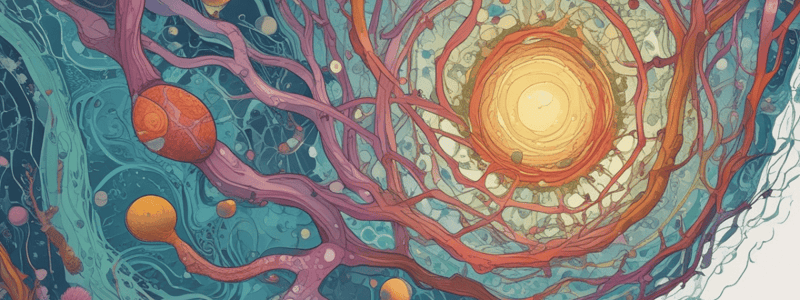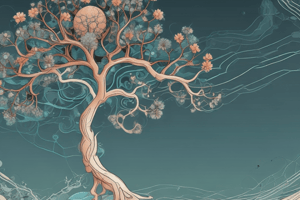Podcast
Questions and Answers
Which branch of biology studies the interactions between organisms and their environment?
Which branch of biology studies the interactions between organisms and their environment?
- Botany
- Ecology (correct)
- Microbiology
- Zoology
What is the basic structural and functional unit of life?
What is the basic structural and functional unit of life?
- Organ
- Cell (correct)
- Tissue
- Organism
What is the primary function of mitochondria in a cell?
What is the primary function of mitochondria in a cell?
- Producing proteins
- Storing genetic information
- Generating energy (correct)
- Transporting molecules
Which of the following is NOT a component of DNA?
Which of the following is NOT a component of DNA?
What is the process by which individuals with favorable traits are more likely to survive and reproduce?
What is the process by which individuals with favorable traits are more likely to survive and reproduce?
Which of the following is a biotic factor in an ecosystem?
Which of the following is a biotic factor in an ecosystem?
What type of biological molecule provides energy and structure for cells?
What type of biological molecule provides energy and structure for cells?
What is the energy currency of the cell?
What is the energy currency of the cell?
Flashcards are hidden until you start studying
Study Notes
Branches of Biology
- Botany: study of plants
- Zoology: study of animals
- Microbiology: study of microorganisms
- Ecology: study of interactions between organisms and their environment
- Biochemistry: study of chemical processes within living organisms
- Genetics: study of heredity and variation
- Molecular Biology: study of biological molecules and their interactions
Cell Biology
- Cell: basic structural and functional unit of life
- Cell membrane: semi-permeable membrane that surrounds the cell
- Cytoplasm: jelly-like substance inside the cell membrane
- Nucleus: contains genetic material (DNA)
- Mitochondria: generates energy for the cell through cellular respiration
- Chloroplasts: responsible for photosynthesis in plant cells
Genetics
- DNA (Deoxyribonucleic acid): genetic material that contains instructions for development and function
- Genes: units of heredity that carry information from one generation to the next
- Chromosomes: thread-like structures that carry genes
- Traits: characteristics that are determined by genes
- Inheritance patterns: how traits are passed down from parents to offspring
Evolution
- Theory of Evolution: explains how species change over time through natural selection
- Natural Selection: process by which individuals with favorable traits are more likely to survive and reproduce
- Speciation: process by which a new species emerges from an existing one
- Fossil Record: provides evidence of evolutionary history
- Comparative Anatomy: study of similarities and differences in body structures between species
Ecosystems
- Ecosystem: community of living and non-living components that interact with each other
- Biotic factors: living components (organisms)
- Abiotic factors: non-living components (environmental factors)
- Energy Flow: energy is transferred from one trophic level to the next through consumption
- Nutrient Cycling: nutrients are recycled through ecosystems
- Biodiversity: variety of species within an ecosystem
Biological Molecules
- Carbohydrates: provide energy and structure for cells
- Proteins: perform various functions in cells (enzymes, hormones, etc.)
- Lipids: provide energy and structure for cells (fats, oils, etc.)
- Nucleic Acids: contain genetic information (DNA, RNA)
- ATP (Adenosine Triphosphate): energy currency of the cell
Branches of Biology
- Botany: Involves the study of plant life, including their physiology, structure, and interactions with the environment.
- Zoology: Focuses on the diverse aspects of animal life, covering behavior, physiology, and classification.
- Microbiology: Examines microorganisms, including bacteria, viruses, fungi, and their roles in ecosystems and human health.
- Ecology: Studies the relationships between organisms and their surroundings, focusing on ecosystems and environmental processes.
- Biochemistry: Investigates the chemical processes vital for life, including metabolic pathways and molecular structures.
- Genetics: Explores heredity and variations in organisms, addressing how traits are inherited across generations.
- Molecular Biology: Analyzes biological molecules, especially DNA and proteins, and their interactions within cellular processes.
Cell Biology
- Cell: Recognized as the fundamental building block of all living organisms, responsible for all life functions.
- Cell Membrane: Semi-permeable barrier controlling the movement of substances in and out of the cell.
- Cytoplasm: Gel-like substance within the cell that hosts organelles and various chemical processes.
- Nucleus: Organelle that houses DNA, containing the genetic information essential for cell function and reproduction.
- Mitochondria: Known as the powerhouse of the cell, converting nutrients into energy through cellular respiration.
- Chloroplasts: Organelles in plant cells that facilitate photosynthesis, converting sunlight into chemical energy.
Genetics
- DNA (Deoxyribonucleic Acid): Carries the genetic blueprint for the development, functioning, and reproduction of organisms.
- Genes: Specific sequences of DNA that determine various traits and characteristics passed from parents to offspring.
- Chromosomes: Structures made of DNA that organize genetic information; humans typically have 46 chromosomes.
- Traits: Observable characteristics that result from the expression of genes, influenced by environmental factors.
- Inheritance Patterns: Refers to the mechanisms through which traits are transmitted from parents to offspring, including dominant and recessive patterns.
Evolution
- Theory of Evolution: Proposes that species adapt and change over time driven by the process of natural selection.
- Natural Selection: Mechanism by which advantageous traits increase an organism's chances of survival and reproduction.
- Speciation: The evolutionary process leading to the formation of new species, often as a result of isolation and genetic divergence.
- Fossil Record: Collection of preserved biological remains that provides insight into the evolutionary history of life on Earth.
- Comparative Anatomy: Examines structural similarities and differences between species to understand evolutionary relationships.
Ecosystems
- Ecosystem: A complex network of living (biotic) and non-living (abiotic) elements that interact and sustain life.
- Biotic Factors: Include all living organisms within an ecosystem, such as plants, animals, and microorganisms.
- Abiotic Factors: Comprise non-living components like climate, soil, water, and nutrients that affect organism survival.
- Energy Flow: Describes how energy moves through an ecosystem, primarily from producers through various trophic levels to consumers.
- Nutrient Cycling: The continuous movement of nutrients through biotic and abiotic components, ensuring ecosystem health.
- Biodiversity: Refers to the variety of life in an ecosystem, which contributes to resilience and stability against environmental changes.
Biological Molecules
- Carbohydrates: Organic compounds serving as primary energy sources and important structural components in cells.
- Proteins: Essential biomolecules that perform a myriad of functions, including catalyzing reactions (enzymes), providing structure, and performing transport duties.
- Lipids: Diverse group of hydrophobic molecules, including fats and oils, critical for energy storage and cell membrane structure.
- Nucleic Acids: Biological molecules like DNA and RNA that store and transmit genetic information.
- ATP (Adenosine Triphosphate): Known as the cell’s energy currency, it is pivotal for powering various cellular activities.
Studying That Suits You
Use AI to generate personalized quizzes and flashcards to suit your learning preferences.




